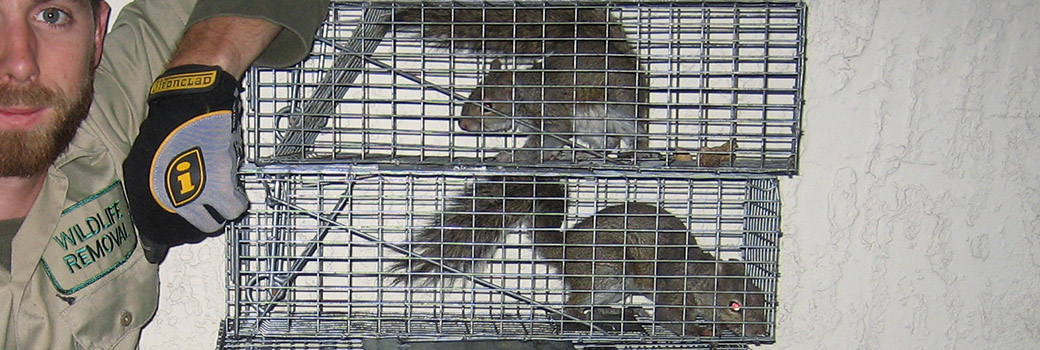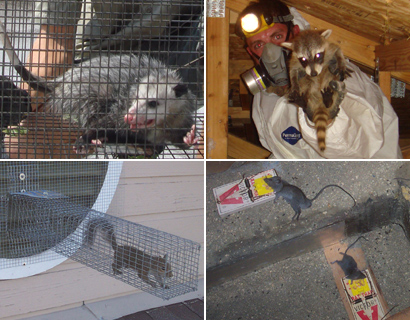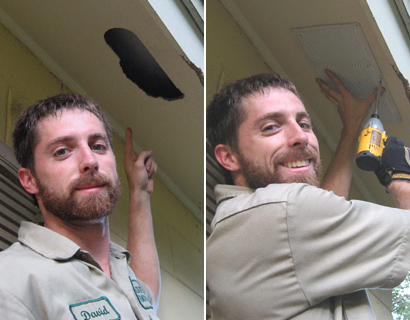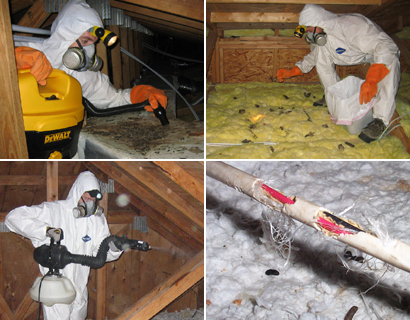- How We Solve Florida Wildlife Problems
How We Solve Tampa Wildlife Problems
INSPECTION: Once on site, we will perform a full inspection of your home and property. This allows us to use the correct strategy and traps. If the animals are in an attic, a full building inspection is crucial, including the following:
- All ground-level areas, such as piper or A/C line entry & exit areas, A/C chase bottoms, ground-level vents, etc.
- All mid-level areas, such as dryer vents, siding gaps, first floor eaves or dormers, etc.
- We inspect the entire roof, including all plumbing stacks, ridge caps, vents, and other potential gaps or holes.
- We also inspect inside your attic, to identify animals and damage they have caused.
- If the animals are outside, we notice many subtle clues that will assist us in a successful strategy.
TRAPPING, EXCLUSION, REMOVAL: Once we understand what animal species we are dealing with, and the problem, we use the most effective means of removing the animals. We use dozens of different types of traps.
- Trapping - If trapping the animal(s) in live cage traps, trap type, set, and location are crucial to success.
- Exclusion - Oftentimes, we are able to simply set one-way doors or other exclusion devices that allow the animals inside a building to safely exit, but never get back inside.
- Removal By Hand - Sometimes we actually remove animals by hand, or with special tools like snare poles.
- The Law - In all cases, we obey state and local laws regarding wildlife, but aim to take the most humane approach.
ENTRY HOLE REPAIRS: Repairs are a crucial step in the wildlife removal process. In many cases, such as bat or rodent control, the job cannot be performed without detailed repairs, and in all cases, sealing the entry holes shut ensures that no future wildlife will ever enter your home.
- 100% of the entry holes must be found, and sealed shut, or the job is not complete.
- Our repairs are professional contractor grade, look good, and when applicable we use steel, which rodents such as rats or squirrels are unable to chew through.
- We give a written guarantee on our repairs against any future animal entry.
ATTIC DECONTAMINATION SERVICES: It may be desirable to clean your attic after we've removed the animals. They can leave behind large amounts of droppings, urine, hair, oils, food, nesting material, and so on. These remnants can attract insects like cockroaches, and the scent left behind can encourage new animals to chew their way into your house. You might experience odor problems from the waste. It's possible that mold will grow on waste areas.
- We remove or vacuum all droppings, or remove all the soiled insulation.
- We fog the attic with a special enzyme-based cleaner that destroys any organic matter and deodorizes the space.
- We repair damage, such as ductwork, electrical wires, pipes, insulation, and more.
Have you been finding holes leading under your porch or home? If you answered yes, then you may have some type of Florida wildlife living under your porch or home. There are many different types of wildlife that could be living under your property, such as: a snake, raccoon, opossum, groundhog, ect. We answer our phones 24 hours a day, seven days a week so we can service your needs when you need them to prevent these creatures from damaging your property or putting your family and pets at risk. We proudly handle trapping as well as removal. We service the following cities: Bayonet Point, Elfers, Greater Northdale, Gulfport, Holiday, Hudson, Jasmine Estates, Keystone, Lealman, New Port Richey, Oldsmar, Palm River-Clair Mel, Safety Harbor, Seminole, Spring Hill, Greater Sun Center, Tarpon Springs, Thonotosassa, University, Valrico, West Lealman, Zephyrhills, Clearwater, Saint Petersburg, Bloomingdale, Brandon, Citrus Park, Dunedin, Egypt Lake, East Lake, Carrollwood, Keystone, Lake Magdalene, Lakeland, Land O' Lakes, Largo, Lutz, Palm Harbor, Palm River, Pinellas Park, Plant City, Riverview, Spring Hill, Tarpon Springs, Temple Terrace, Town 'n' Country, Valrico, Wesley Chapel, and Westchase. We also service the following counties: Hernando County, Pasco County, Pinellas County, Manatee County, Sarasota County, and Polk County.
Other Tampa animal pest control topics:
What Areas Can Bats Enter a House
Should I Hire a Pro, or Remove Raccoons Myself
Humane Ways to Kill a Wild Animal in a Cage
Do Rats Chew in Wires
To learn more about our services, visit the Tampa wildlife control home page.
This month's wildlife how-to article: How to catch a squirrel with a snare pole
How to catch a squirrel with a snare pole
Catching a squirrel with a snare pole is one of the easiest ways to ensure that a squirrel is not harmed in anyway when catching it. Your first step is a build a squirrel pole if you can’t find one. Here are the steps you should follow:

Step 1: spot a tree or place that shows recent squirrel activities within your home, then look for a medium-sized limb that is between 3 and 5 inches long, and with a diameter of about 3 inches. If possible, find a limb that still contain some foliage on it- this will help camouflage the squirrel snare wire.
Step 2: Take the limb and then wedge it against the trunk of a tree at a 45 degree downward angle. You can simply place a medium-sized stone at the bottom of the runway limb ad at the ground level, to provide some support for the wedge.
Step 3: construct the squirrel snare out of a wire, and simply attach them to the runway at several angles and at different diameters apart. To create the perfect snare, simply cut about 10-inch length of the snare wire and create a small loop at the wire’s end. Gently twist the wire and then take the other end, running through the other twisted loop that you have created earlier. Then fasten the squirrel snare around the pole or tree and make sure they are tightly twisted together. It is ideal to set a snare that is 2 inches in diameter and about 1 ¼ inches over the runway- this will ensure that the squirrel runs through the snare head first and eventually get snared around the stomach or hip region.
Step 4: To make your snare more effective, you should consider covering it partly with some leaves or debris or even add some tasty foods such as butternuts, nuts, seeds and grains to attract squirrel until it get caught up in the snare. Once the squirrel has been trapped within, try as much as possible to remove it alive , otherwise you may have to strangulate it if you find the animal struggling to escape. If the animal is badly injured, you can decide to put it in a temporary cage with some food and water while you treat its wounds, otherwise, you may have to dispose the body somewhere safe
Though this method of catching a squirrel is generally effective, however, you may have to kill the squirrel by yourself, especially of the snare does not strangulate it . Sometimes you may have to capture the animal in an injured state , this may seem too cruel to some people who may prefer some other mechanical alternatives.





